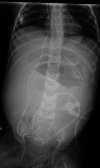Small Bowel Obstruction and Enterococcus Meningitis: Rare Complications of Ventriculoperitoneal Shunt Placement
- PMID: 37465815
- PMCID: PMC10351929
- DOI: 10.7759/cureus.40575
Small Bowel Obstruction and Enterococcus Meningitis: Rare Complications of Ventriculoperitoneal Shunt Placement
Abstract
A ventriculoperitoneal (VP) shunt is a commonly used mechanical device indicated for congenital and acquired hydrocephalus in children. Although VP shunt failure is not uncommon, the symptomatology and cause of failure can vary. In this case, we describe intestinal obstruction in a three-year-old Caucasian female with a history of Pilomyxoid Astrocytoma and VP shunt placement for the management of hydrocephalus. Surgical exploration revealed ischemia of the terminal ileum secondary to VP shunt tubing-induced adhesions requiring bowel resection. A secondary VP shunt infection due to Enterococcus faecalis was also noted. Our case highlights a unique presentation of intestinal obstruction and infection that should serve to increase provider suspicion when evaluating patients presenting with abdominal distention and pain with presence of a VP shunt.
Keywords: endoscopic third ventriculostomy; gram-positive meningitis; pilomyxoid astrocytoma; small-bowel obstruction; ventriculoperitoneal shunt.
Copyright © 2023, Gonzalez et al.
Conflict of interest statement
The authors have declared that no competing interests exist.
Figures



References
-
- Pediatric brain tumors. Udaka YT, Packer RJ. Neurol Clin. 2018;36:533–556. - PubMed
-
- Pilocytic astrocytoma: a review of general, clinical, and molecular characteristics. Salles D, Laviola G, Malinverni AC, Stávale JN. J Child Neurol. 2020;35:852–858. - PubMed
-
- Knight J, De Jesus O. In: StatPearls [Internet] Treasure Island, FL: StatPearls Publishing; [ Apr; 2023 ]. 2023. Pilocytic astrocytoma. - PubMed
-
- Management of hydrocephalus after resection of posterior fossa lesions in pediatric and adult patients - predictors for development of hydrocephalus. Won SY, Dubinski D, Behmanesh B, et al. Neurosurg Rev. 2020;43:1143–1150. - PubMed
-
- CSF shunts 50 years on--past, present and future. Drake JM, Kestle JR, Tuli S. Childs Nerv Syst. 2000;16:800–804. - PubMed
Publication types
LinkOut - more resources
Full Text Sources
